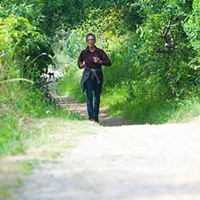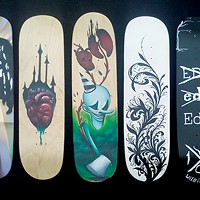[
{
"name": "Top Stories Video Pair",
"insertPoint": "7",
"component": "17087298",
"parentWrapperClass": "fdn-ads-inline-content-block",
"requiredCountToDisplay": "1"
}
]
Over the last five years, the cracks and crannies of Arcata's sidewalks have eaten me up and the unpredictable weather left me with a heavy and rusted cruising setup. It was time to get something new to roll around the sleepy town with. Steven Driedger's boards caught my eye with their color and shape, so I visited his workshop.
In a quiet corner of Sunny Brae in Arcata, the sounds of a small woodworking operation bounced through a redwood backyard. A workbench held a table saw, a sander, wood glue and everything else Driedger needs to build a custom skateboard. (You can scroll down and take a peek at the process in the video below.)
"The nose of the board is going to sit right there," he said as he marked the edge of the wooden planks with a blue pen. He lined up six slices of nicely grained hardwood as he stepped back to picture the soon-to-be skateboard deck cut out and ready to ride through the Arcata streets.
The home of the skateboard builder is full of college students, mismatched furniture and two dogs that never stop playing. It takes Driedger about five days to build a skateboard deck from scratch between a part-time job making coffee at Dutch Bros. and volunteering his time with the Arcata Fire District.
"Now that I am up here, I've been getting that urge to build and create things again," said Driedger, who moved to Arcata to attend Humboldt State University, from which he graduated in 2014 with a degree in Recreation Administration.
"I've learned to be picky with the wood I use," Driedger said. "The first board I used had kind of a soft core and now I've become pretty picky with the strength of the wood."
The process is simple for him. He learned woodworking from his dad in his Southern California childhood home in Santa Clarita. Driedger was in community college when he built his first board — back then, he said, he had to park about 2 miles away from his place because he wasn't on the lease and couldn't get a parking spot. "I got really tired of walking 2 miles to my car and back to my studio, so I needed a skateboard."
Some his recent skateboards are made up of purpleheart, zebra, Chechen and Wenge hardwoods that were imported from all over the world. The largest piece of wood will go in the center and bear the weight of the trucks and wheels.
"I'm just building these skateboards in my backyard. I'm hanging out in Humboldt and feasting on all its goodies. Going outside and adventuring and camping and backcountry hiking and enjoying breweries and the buddies that are still up here," Driedger said.
Driedger models and carves the boards with the design of a small surfboard, complete with an old-school '70s fishtail. I had my eye on one made from a large slab of straight grained purpleheart that contrasted with the zebra wood to its side. The size was exactly what I wanted: not too big to be bulky in my arms and not small enough to be uncomfortable on the road. Of course, I had to get on one before making my final decision. With a confident push from my left foot, I began to carve my way down Driedger's street.
With these boards, you're going to feel character of the road under your feet — every bump and divot. There's no flex and zero tail to pick up the nose. It takes a little getting used to. While this may seem like a negative for a cruiser, there's something genuine about riding handmade artwork through Arcata roads. Once you get used to how they ride, you'll find that they pump a lot more like a surfboard on a concrete wave.
"It's not compressed wood like the trick decks you see; those are designed to have some flex. These are hardwood so they're not supposed to be stomped on and that's why they're meant for cruising," Driedger said.
Building Sidewalk Surfers: Making Handmade Skateboards in Humboldt from Sam Armanino on Vimeo.
After Driedger selects individual planks of wood, it's time to measure and make the first cuts. He lines the strips of wood to his table saw and triple checked his measures. After the pieces are in place, he cuts small indents in the wood and glue them together. Each board will sit tight, between six clamps, for more than 24 hours before it's ready.When it's dried solid, Driedger takes the board to Almquist Lumber Company to take down a few centimeters on the top and bottom. He cuts and sprays on a special glass epoxy for grip. "It's really for the grain to pop out from under the grip," he said.
I was sold when he said he never makes the same board. Mind you, that isn't cheap — they range from $150-$200 for a 30-inch cruiser and $180-$200 for a long board. Some may look similar and they all have the same short fishtail surf cut, but Driedger said he makes each board custom and isn't interested in changing anytime soon.
"Right now I'm not taking it too seriously," Driedger said. "I'm just rolling with it. It's kind of a fun side hobby. As long as people want a board made, I enjoy making them and I'll do it. But I'm not going to mass produce a bunch of boards."
You can reach Steven Driedger via email at [email protected] and check out his work on Instagram @humbalay.
Speaking of...
-

NCJ Preview: HSU's Polytechnic Hopes and a Skate Ramp Grows in Petrolia
Feb 13, 2021 -

The Phoenix Approach
Jan 17, 2019 - More »
Comments (2)
Showing 1-2 of 2
more from the author
-
A Gift of Glasses: Three Eureka Men See the World in a New Hue (Video)
- Dec 12, 2018
-
Hitting the Water
- Jun 11, 2018
-
Caps and Gowns
- May 14, 2018
- More »
Latest in Get Out
Readers also liked…
-
A Walk Among the Spotted Owls
- Apr 27, 2023


































